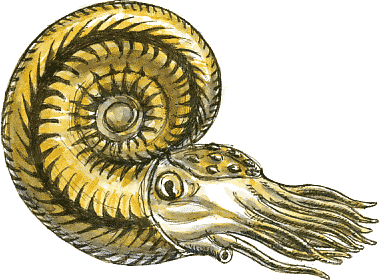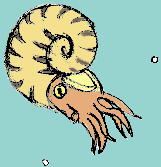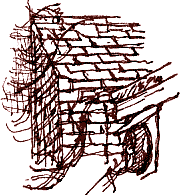Goniatite
Richard Bell's Wild West Yorkshire Nature Diary, Thursday, 25th March 2010
previous | home
page | this month | e-mail
richard | next

 IF
WE COULD go back 320 million years, to the Carboniferous period
at the time when the millstone grit of the Pennine moors was
laid down in large river deltas, this is one of the creatures that you'd have
come across in the tropical seas that occasionally flooded the whole of West
Yorkshire, leaving thin but extensive marine bands that can
sometimes be traced from Ireland to Russia.
IF
WE COULD go back 320 million years, to the Carboniferous period
at the time when the millstone grit of the Pennine moors was
laid down in large river deltas, this is one of the creatures that you'd have
come across in the tropical seas that occasionally flooded the whole of West
Yorkshire, leaving thin but extensive marine bands that can
sometimes be traced from Ireland to Russia.
This goniatite, Reticuloceras reticulatum,
had a shell the size of a large coin. Reticuloceras means 'horn covered
with a network of veins' while goniatite, the name of the genus
to which it belonged, refers to the angular joints (sutures) in the shell.
They were related to the later ammonites, best
known in Yorkshire from fossils you can pick up on beach which have weathered
out of Jurassic rocks. But they date from a hundred million years after the
goniatites.
Of course when imagining what it might have looked like I have
no idea whether the shell was decorated as I've shown it but I can be reasonably
confident that the creature that lived in it would have resembleds a modern
squid but the protective flap on its head is something I've taken from its present-day
relative, the Nautilus.
Its eyes might have given it a view of the world that wouldn't
look so very different from the view as we might see it, except the creature
wouldn't have had much in the way of binocular vision; the eyes were on the
sides of its head to give it almost a 360 degree view of the aquatic
world all around it. Almost, but not quite; we know that the later ammonites
were targetted by predators which knew to approach from its blind-spot, from
behind and below.
This drawing is for a geology trail leaflet that I've been working
on for the past week or so.
 Caledonian
Slates
Caledonian
Slates
These Welsh slates on the roof of the extension at the back of
one of the shops on Horbury High Street also had a marine origin. Welsh slate
started out as mud on the ocean bed some 500 million years ago then about 400
million years ago it was compressed and given its slaty cleavage in the Caledonian
mountain-building episode, when the primordial versions of 'North America' and
'Europe' collided due to continental drift.
previous | home
page | this month | e-mail
richard | next

 IF
WE COULD go back 320 million years, to the Carboniferous period
at the time when the millstone grit of the Pennine moors was
laid down in large river deltas, this is one of the creatures that you'd have
come across in the tropical seas that occasionally flooded the whole of West
Yorkshire, leaving thin but extensive marine bands that can
sometimes be traced from Ireland to Russia.
IF
WE COULD go back 320 million years, to the Carboniferous period
at the time when the millstone grit of the Pennine moors was
laid down in large river deltas, this is one of the creatures that you'd have
come across in the tropical seas that occasionally flooded the whole of West
Yorkshire, leaving thin but extensive marine bands that can
sometimes be traced from Ireland to Russia. Caledonian
Slates
Caledonian
Slates